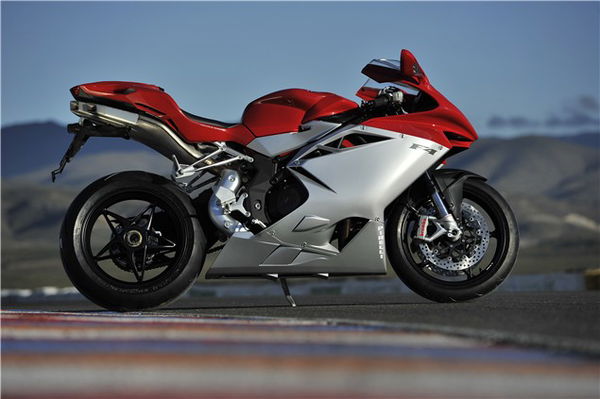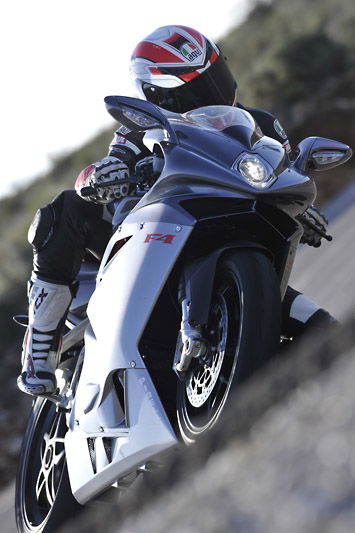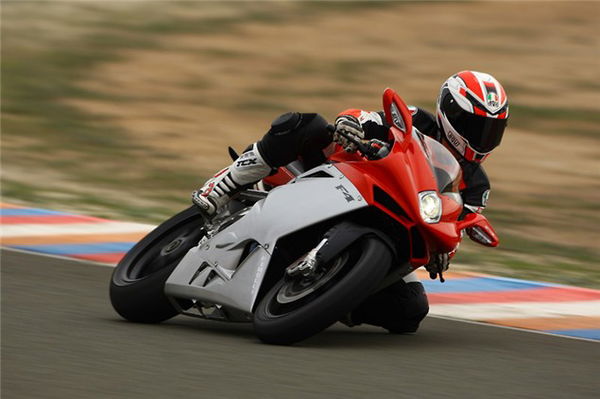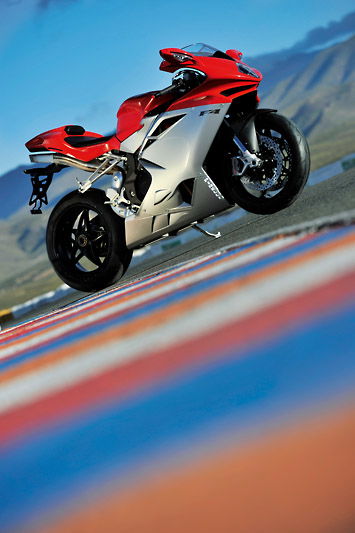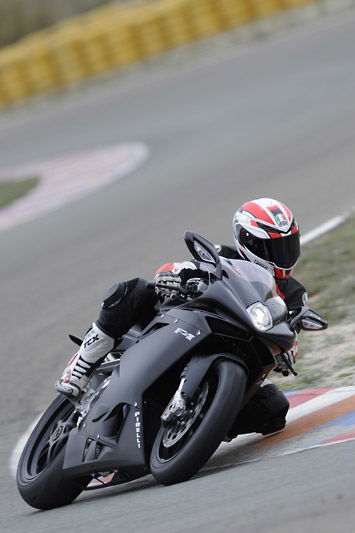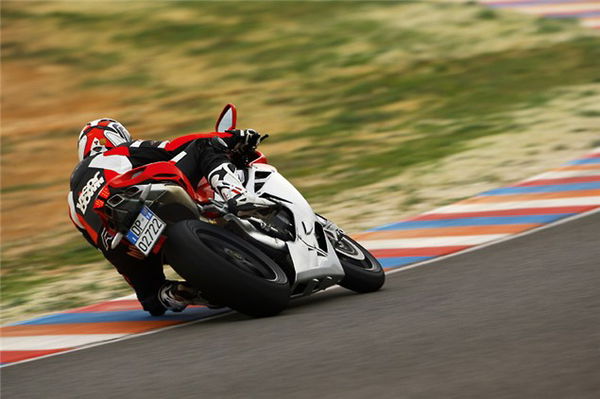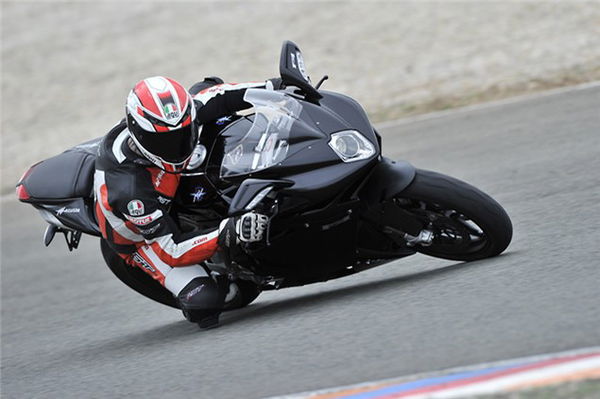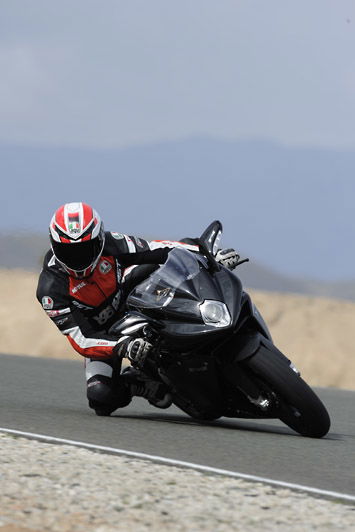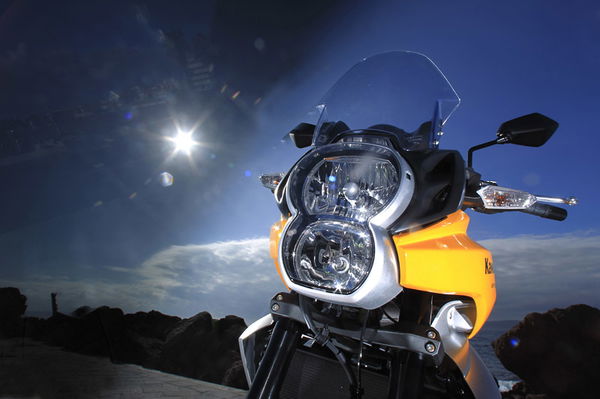First Ride: 2010 MV Agusta F4 1000R launch test review
Visordown’s Chief road tester is former World Supersport star and all-round top chap James Whitham. MV Agusta generously allows him to sample the new F4. Is he a happy chappy? Or utterly disgusted with Agusta? Find out
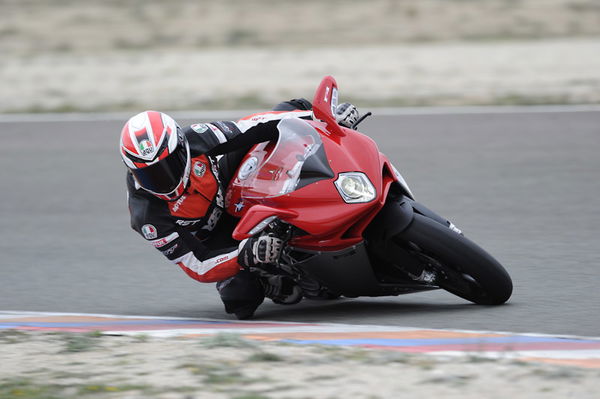

Click to read: MV Agusta F4 1000R owners reviews, MV Agusta F4 1000R specs and see the MV Agusta F4 1000R image gallery.
The press conference part of this launch was different to most I’ve sat through.
Usually it’s all about technical changes to the new model, how a certain component is 15% more efficient, another is 200 grams lighter and another has more tortional stiffness. Very little is usually said about aesthetics or design concepts.
With the new MV F4 they explained that the new bike was 10kgs lighter and talked about various other important improvements but most of the spiel in the classroom came from the bodywork designers, the blokes who designed the actual shape and look of the thing. Coming as I do from a racing background I’m much more interested in function rather than form. If a new bike performs better or gives you better lap times it always looks good.
The engineers were at pains to tell us that every single component that made up the old F4 has been evaluated, redesigned, re-engineered or relocated to improve upon the old model and give the new F4 ‘class-leading performance and handling’ err, righto then chaps... but let me tell ya, the old model needed a bit of improving.
Last year’s F4 312 although good looking and just about OK on the track, was a nightmare on the road. The riding position was uncomfortable, the suspension so hard it hurt, the clutch so grabby it was impossible to set off smoothly, and the motor had strong top-end but the fueling was all over the place making the throttle like an on-off switch in the corners. It made the most experienced rider look like a blundering novice. The new bike had to be a lot better if it was going to be a contender. Yup, I was pretty sure I was gonna be giving this bike a right old slating. But I couldn’t because I liked it.
As soon as I set off on the new bike I could feel it was going to be a better machine, even before I’d ridden out of the Almeria circuit gates heading for the twisty mountain roads I knew I was dealing with a totally different animal here. The new bike is so much better than the old one, in virtually every aspect, it’s difficult to believe it’s out of the same factory.
The roads around Almeria up into the foothills of the Sierra Nevada are perfect for getting the feel of a big sports bike. You come across almost every kind of bend on this constantly twisting bit of tarmac. This bike inspired confidence from the get-go.
The three main changes that have improved the F4 are in suspension, feel from the front-end and the character of the motor.
A claimed (and impressive) 186bhp at the crank is an identical figure to the old 312 F4, but a redesigned, heavier crankshaft, variable throttle body intakes and a totally remapped Magneti Marelli ECU gives the new one more torque and a smoother, more controllable power delivery. It’s still a motor that likes to rev hard, giving it’s max at 12,800 rpm but it’s just as happy cruising through the bends in a high gear pulling from 5 or6 K.
The fueling’s sorted too. Picking up the throttle in the middle of a bend is easy, the power comes in progressively with no scary holes or spikes like before.
The standard suspension settings are right in the ball park too. Firm enough to let you feel what the chassis is doing but soft enough to be reasonably comfy for general riding, certainly no more harsh than any other modern sportsbike. This aspect of set-up is always going to be a compromise. A pin-sharp track bike would be so firm that it’d rattle your fillings before you’d done ten miles on the road. And a bike that gave you magic-carpet comfort on a bumpy road would handle like a Vespa with a flat tyre if you took it on track.
How MV made big changes to the F4 without losing its good looks
Strange to find that the senior designer of this very Italian bike is a Brit. Adrian Morton and his colleague, Fabio Landi were responsible for the new bike. I was keen to find out if there was any conflict between them and the engineers that had to improve how the bike performed. It’s all well and good producing a motorcycle work of art if you work for American Chopper, but in the one litre sports bike category, if it don’t perform, the looks are irrelevant.
Morton explained that although every angle and view of the new bike is different, the company felt the original design had aged exceptionally well and wanted to retain the overall look but bring it bang up to date. The design brief therefore was fairly tight. They were asked to make the bike look more modern and more aggressive but many aspects of the original design had to stay, to retain the ‘MV DNA’ as they put it. The four underseat exhaust stacks had to stay, as did the single sided swingarm. They also knew they would be working around the same basic frame/engine layout and dimensions.
For their part, the actual engineers knew what aspects of the bike’s performance they had to sort out. Power delivery, weight, suspension, and rider comfort were the main issues to be addressed. The only impact this had on Adrian’s work was that he was told to make the riding position better, especially for taller riders, and make the frontal shape more efficient for air intake, both for allowing the motor to breath better and for cooling. They managed this and made the nose 40mm narrower!
Very little of the design was done using CAD. Much importance was put on how this bike would look in the flesh, it was felt that doing it the old way with clay, so they could actually look at it instead of just squinting an image on a screen would be better. They also said working the old school way was more enjoyable too.
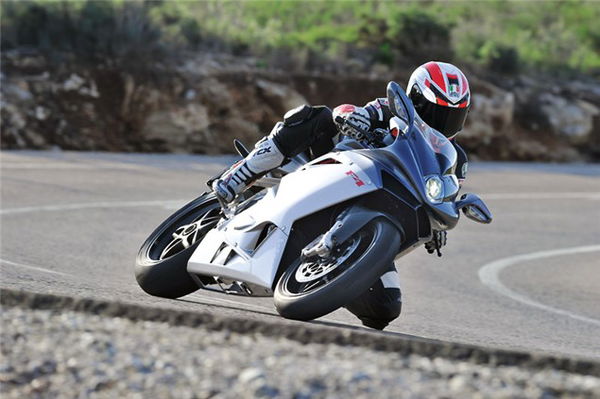
In this respect I reckon the MV has a pretty good balance between the two. In any case, if you feel like twiddling, the Marzocchi forks up front are adjustable for both damping and pre-load, and the Sachs rear shock comes with high and low speed damping adjusters. The rear ride-height is easily adjusted too by changing the length of the suspension link arm, a five minute job in this case.
Although the general layout of the chassis is the same as it’s always been, steel trellis frame mated to an aluminium single-sided swingarm, it seems to work better. It steers into turns predictably and once on its side this bike holds a line as well as any sports bike, with a lovely neutral feeling to the bars. It actually wants to turn. You feel like you could let go of the bars mid-corner and the bike would just keep going round. This gives you confidence, especially on roads you’re unfamiliar with.
Back at the Almeria circuit it didn’t let itself down either. The ability of a bike to hold a line in a long, constant radius corner is an advantage at any track but at this one it’s a necessity. Three times in a lap you have to commit to a turn over a blind crest and if a bike struggles to hold a line you have your work cut out here. The original R6 was a pig in this respect. It’d turn in well but once you cracked the throttle open mid-corner it’d start pushing wide. You always seemed to be hauling over a crest, eyes staring where you want the bike to go but always being two or three feet wide of it. The F4 turns in OK and then seems to go just where you want it to – no trouble at all. Even squeezing the gas open it stays on the same line.
Something else that gives you confidence is the Magneti Marelli traction control system. It works by monitoring throttle opening, lean angle and the rate of crankshaft acceleration. It’s dead simple to set; highlight ‘traction control’ on the digital dash, scroll through numbers 0 to 8 (0 being no traction control and 8 being lots) and hold down the ‘set’ button. It works.
Actually I’d better quantify that, I’m not saying you can set it on a high number and then go around pinning the twist grip against the stop with impunity. But I tried every setting and certainly from three upwards I could feel it kicking in. On the high numbers it’d come in five or six times a lap, over all the crests and every time you went over a curb on the exit of a turn. I found number 4 the best for me. On this setting, some laps you couldn’t feel it but if you tried hard, especially on the faster bits and when the tyre was worn, it was there.
I would’ve liked to have a go in wet conditions to see how it performed then, I reckon for most road riders it’d be when traction control would be most relevant.
The dash displays everything you’re ever likely to need to know and then some. There are good old fashioned lights around the outside of the digital bit for indicators, neutral, high beam, etc, but they’re a bit on the dim side and difficult to see, particularly in bright sunshine but all the same info is duplicated digitally anyway, so no worries. It also has a series of gear-change lights, orange ones come on once you get over 12,200 rpm and then red flashes just before you hit the 13,500 rev limit, but by then you’re going that fast you daren’t look down anyway.
Once I really started caning it on track, the change of direction through Almeria’s second gear chicane was starting to feel a little slow but could be easily sorted by upping the ride-height 5 or 6 mm. The bike also seemed fairly sensitive to tyre wear. With worn tyres you could feel the rear moving, especially under heavy braking. And the mirrors were only any use if you wanted to inspect your own armpits.
Overall I was really impressed with the new MV Agusta and that surprised me. Because I didn’t like the old one too much at all and although lots about the new bike has changed in some way, it still looks pretty similar, so I was expecting it to ride the same too. For me it was a case of the new bike being guilty till proven innocent but it was a comfortable, easy-to-ride sportsbike with good road manners, mad top-end power and truly superb build quality and finish.
Some of the other journos on the test said it was a little bit small for the taller rider and lacked leg room. The irony is that the foot rests on this bike are fixed, the old one has had adjustable pegs for the last 12 years. Doh !
When you consider how good the new F4 is, and with a list price of £14,250 (2010 R1 is £12,600 !) buying an MV starts to look a lot less silly than it used to.
2010 MV Agusta F4 1000R Specifications
Price £14,250
Top speed 185mph Engine 998cc, 16-valve, liquid-cooled inline four
Bore x stroke 76mm x 55mm Compression ratio 13.1:1
Power 186bhp at 12,900rpm Torque 55.7lb.ft at 6,250rpm
Front suspension 50mm inverted forks Adjustment rebound, compression and preload
Rear suspension Monoshock Adjustment rebound, compression and preload
Front brakes 320mm discs, 4-pot radial calipers Rear brake 210mm disc, 4-pot caliper
Dry weight 192kg (423lbs) Seat height 860mm Fuel capacity 17-litres
Colour options Red, silver, black
